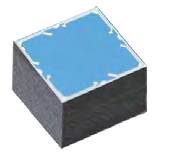

■ High-purity monocrystalline silicon
■ Double-beam suspended MEMS structure
■ Ultra-high overpressure performance
■ 1kPa standard range
-High purity monocrystalline silicon material
BW-MD series monocrystalline silicon chips are made of ultra-high purity monocrystalline silicon, which is superior to the composite and diffusion silicon materials commonly used in the market. With this, Beiwei also breaks the pattern that this material is monopolised by only a few excellent sensor companies in the world.
-Double Beam MEMS Design
Beiwei BW-MD series monocrystalline silicon sensor chip adopts the classic Wheatstone bridge principle, but innovatively adopts dual Wheatstone bridges in the bridge design to realise a "double beam" on the bridge. The double-beam bridge circuit, with complementary temperature characteristics of the bridge resistance, achieves self-compensation when the bridge circuit undergoes self-heating changes or noise interference, which significantly improves the chip's anti-interference capability and long-term stability.
-Suspended MEMS structure
BW-MD series monocrystalline silicon sensor chips are made of all monocrystalline silicon, the sensing layer and the base layer are bonded with silicon-silicon to improve the hydrostatic characteristics of the chip (much better than the traditional silicon-glass bonding), and at the same time, a suspension layer of inert material with μm thickness is added between the sensing layer and the base layer to greatly reduce the impact of stress and improve the insulating characteristics.
-1kPa ... 40MPa Standard range
The seven standard ranges of 1kPa, 6kPa, 40kPa, 100kPa, 400kPa, 4MPa and 40MPa cover the full range of gauge, differential and absolute pressures for process control.
-Better overpressure performance
1kPa chip overpressure up to 1.5MPa (1500 times overpressure) 6kPa chip overpressure up to 2.5MPa (417 times overpressure) With this excellent overpressure performance, the vast majority of microdifferential pressure applications can be realised without the protection of the diaphragm structure, improve the overall accuracy and static pressure characteristics, while simplifying the structure of the sensor, reducing costs.


 +86 189 2129 2620
+86 189 2129 2620
+86 176 0611 8008 sales@bwsensing.com
sales@bwsensing.com














